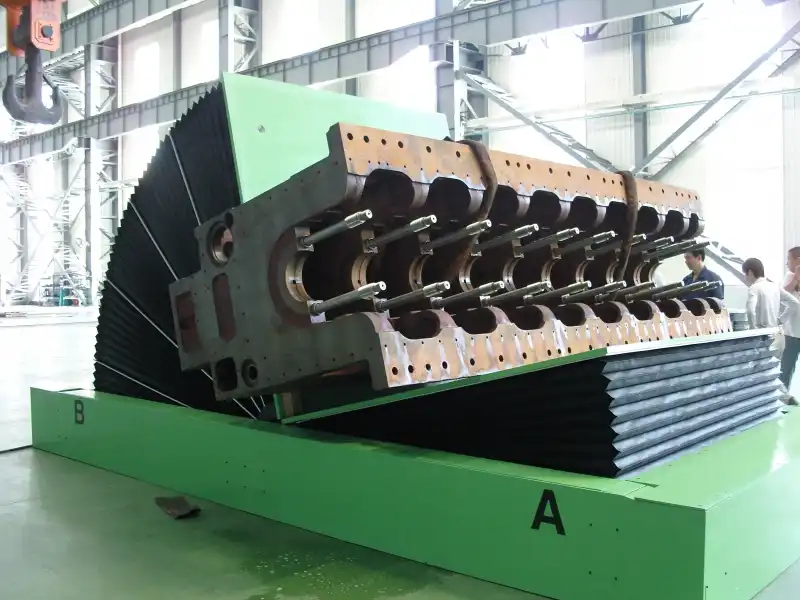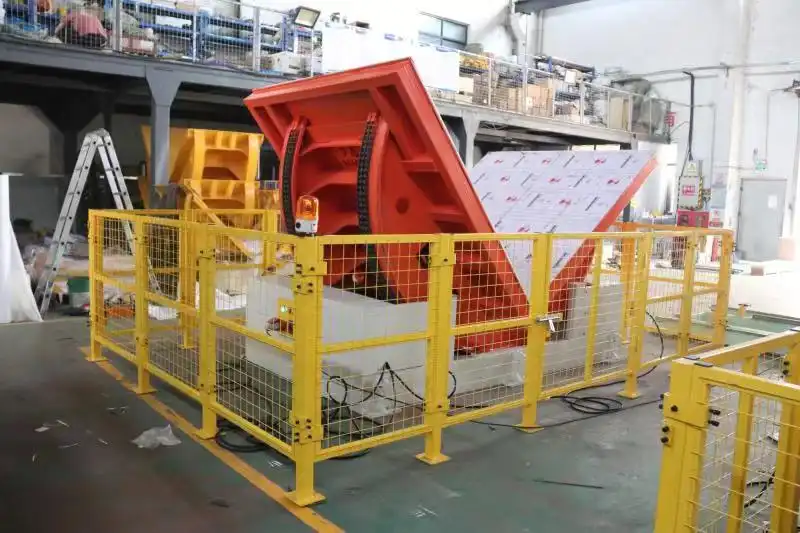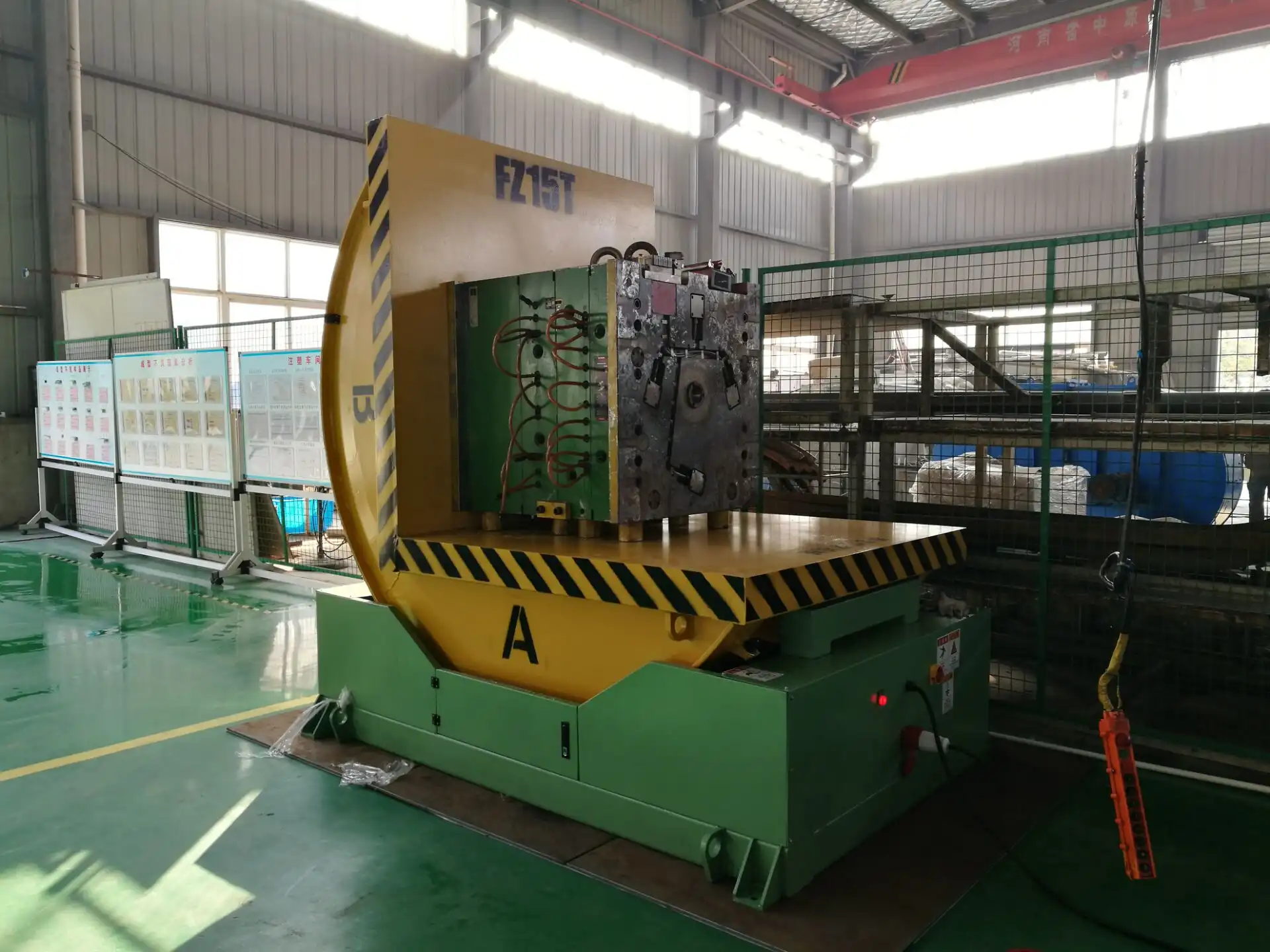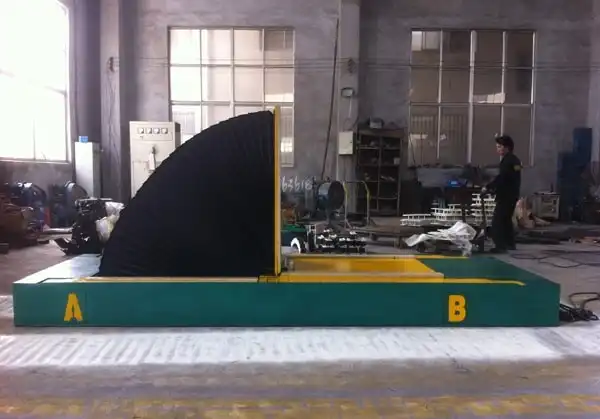Your steel plant in Brazil is under constant pressure. You face fluctuating energy costs and demanding production targets. Every part of your operation must be efficient. But have you looked closely at your mold handling process? An outdated, manual system can create hidden bottlenecks. These delays seem small at first. But they add up, causing significant production losses, increasing safety risks, and hurting your bottom line. It's a problem that silently eats away at your plant's potential.
Yes, your mold handling process is likely holding back production if you rely on outdated cranes and manual labor. This traditional approach often leads to slow changeover times, increased risk of accidents, and damage to expensive molds. In Brazil's competitive steel market, these inefficiencies directly translate to lost revenue and a weaker market position. An inefficient mold handling system is a major bottleneck that prevents you from reaching your full production capacity.

I have spent my entire career in and around factories like yours. I started on the factory floor and worked my way up to building my own packing machine company, SHJLPACK. I understand the immense pressure you face as a plant owner. You need every single process to be optimized. Mold handling is one of those areas that is often overlooked but holds incredible potential for improvement. Let’s explore how this single process could be impacting your entire operation and what you can do about it.
How can outdated mold handling compromise worker safety?
Your team is your most valuable asset. But outdated mold handling practices put them at risk every single day. Using general-purpose cranes with chains or slings to flip heavy, awkwardly shaped molds is a recipe for disaster. One slip, one moment of miscommunication, and you could be facing a serious accident. This not only has a terrible human cost but also leads to production shutdowns, investigations, and damage to your company's reputation. It's a constant source of worry for any responsible plant manager.
Outdated mold handling methods compromise worker safety by creating unnecessary risks of crushing, pinching, and straining injuries. Manual guiding of suspended heavy loads and the unpredictable movement of molds during flipping operations expose your team to significant dangers. A specialized mold upender or tilter provides a controlled, stable, and secure process. It removes workers from the immediate danger zone, drastically reducing the likelihood of accidents and improving overall plant safety.

In my early days as an engineer, I witnessed a near-miss that I will never forget. A team was using a crane to flip a multi-ton mold. The slings weren't perfectly balanced. As the mold was lifted, it shifted unexpectedly and swung violently, missing a worker by inches. Everyone froze. The production stopped, but more importantly, we almost lost a team member. That day, I learned that "good enough" is never acceptable when it comes to safety. This is especially true in a dynamic industrial environment like Brazil's steel sector, where production speed can sometimes overshadow caution. A systematic approach to safety is not an expense; it is a fundamental investment in your people and your plant's stability.
The Dangers of Manual Operations
Manual mold handling is filled with hazards. Workers are often required to be in close proximity to a suspended load. They use their hands to guide the mold, putting them at direct risk. If the load swings or drops, the consequences can be catastrophic. The use of chains and slings also introduces variables. Are the slings rated for the load? Are they positioned correctly? Is the crane operator's view clear? Each of these questions represents a potential point of failure in the safety chain.
Reducing Human Error
A dedicated mold upender is engineered for one task: to handle molds safely and efficiently. It operates with a predictable, controlled motion. The operator stands at a safe distance, using a simple control panel. This automation removes the most unpredictable element from the equation: human error. There's no guesswork in balancing the load and no need for workers to be in the line of fire. It transforms a high-risk task into a routine, safe procedure.
Long-Term Health and Ergonomics
The safety risks aren't just about sudden accidents. Repetitive strain is a serious issue. Manually rigging heavy molds, pushing, and pulling them into position takes a physical toll on your workforce over time. This can lead to chronic back, shoulder, and joint problems, resulting in increased absenteeism and workers' compensation claims. An automated system eliminates these physically demanding tasks, contributing to the long-term health and well-being of your employees. This is a critical consideration for retaining skilled labor.
| Hazard Type | Manual Method (Crane & Slings) | Automated Method (Mold Upender) |
|---|---|---|
| Crushing/Impact | High risk. Workers are in the immediate vicinity of a suspended, potentially unstable load. | Very low risk. The operator is at a safe distance, and the machine provides a stable, controlled motion. |
| Ergonomic Strain | High risk. Repetitive lifting, pushing, and pulling of heavy rigging equipment. | No risk. The process is fully mechanized, eliminating manual physical labor. |
| Load Dropping | Moderate risk. Dependent on sling integrity, correct rigging, and crane operation. | Extremely low risk. The mold is securely clamped or supported on a stable platform throughout the process. |
| Operational Control | Low. Relies heavily on operator skill and communication between team members. | High. The machine follows a precise, pre-programmed path, ensuring consistency and predictability. |
Are manual mold handling methods increasing your operational costs?
Every real you spend on inefficiency is a real taken away from your profit margin. Manual mold handling seems cheap on the surface because you are using existing equipment like overhead cranes. But the hidden costs are substantial. Think about the downtime. How long does it take your team to safely rig, lift, flip, and place a mold? Each minute is lost production time. What happens when a mold is damaged during this clumsy process? The repair costs and the resulting production halt can be enormous. These costs accumulate, quietly eroding your profitability.
Yes, manual mold handling significantly increases operational costs through excessive labor, extended machine downtime, and a high risk of damage to expensive molds. The process requires multiple skilled workers and a crane operator, tying up valuable resources. The slow, deliberate nature of manual flipping extends changeover times, directly reducing your production output. An automated mold upender, by contrast, can perform the same task in a fraction of the time with a single operator, cutting both labor and downtime costs immediately.

I once worked with a client in Brazil whose factory was struggling with profitability despite strong market demand. We did a full process audit. We found that their mold changeover process was a major source of financial drain. It took, on average, 45 minutes and required three people plus a crane. Molds were frequently scratched or dented, leading to costly polishing and repairs. The "soft costs" were even higher. The uncertainty of the process made production scheduling a nightmare. By investing in a simple mold upender, they cut the changeover time to under 10 minutes with one operator. The ROI was less than 12 months, and it was one of the key changes that helped them lower their overall operating costs by nearly 5%.
The Direct Cost of Labor
Let's break down the labor cost. In a manual process, you typically need at least two riggers on the ground and one crane operator. These are skilled positions. Their time is valuable. If a mold change takes 45 minutes, you are paying for over two man-hours of skilled labor for a single, non-value-added task. If you have multiple changeovers per day, this cost multiplies quickly. An automated upender requires only one operator, who can manage the process from a safe distance in minutes. The labor savings alone are significant.
The High Price of Downtime
In the steel industry, time is money. When a production line is down for a mold change, it's not producing steel. This is the biggest hidden cost. A faster changeover means more uptime and higher production output. The difference between a 45-minute manual changeover and a 10-minute automated one is 35 minutes of extra production time. Across a year, this translates into thousands of extra tons of product and a substantial increase in revenue.
Protecting Your Asset: The Mold
Molds are precision-engineered tools and are incredibly expensive. Using chains and slings puts them at constant risk of being dropped, scratched, or dented. Any damage, even minor, can affect the quality of your final product and requires costly, time-consuming repairs. A mold upender is designed to handle these assets with care. It uses wide, stable platforms and soft-contact surfaces to turn the mold smoothly, protecting your investment and ensuring consistent product quality.
| Cost Factor | Manual Method (Crane & Slings) | Automated Method (Mold Upender) | Potential Savings |
|---|---|---|---|
| Labor Requirement | 2-3 Workers + 1 Crane Operator | 1 Operator | 70-80% reduction in labor cost per cycle |
| Cycle Time | 30-60 minutes | 5-10 minutes | 80% reduction in machine downtime |
| Risk of Mold Damage | High | Very Low | Reduces repair costs and production loss |
| Equipment Tie-Up | Ties up a multi-purpose overhead crane | Uses a dedicated, efficient machine | Frees up the crane for other critical tasks |
Does your current mold handling system limit your production flexibility?
The modern steel market in Brazil is not static. Your customers demand a wider variety of products, which means more frequent changes in your production line. Your ability to adapt quickly is key to staying competitive. But what if your mold handling process is slow and rigid? If a changeover takes an hour or more, you become reluctant to switch production to meet smaller, more specialized orders. Your plant becomes less agile. This lack of flexibility can mean losing out on valuable contracts and being stuck serving only the high-volume, lower-margin market segments.
A slow, manual mold handling system absolutely limits production flexibility. Long changeover times discourage frequent production changes, making it difficult to respond to fluctuating market demands or to accept smaller, high-margin orders. This forces you into longer production runs of a single product, reducing your plant's overall agility. An automated mold handling system that enables rapid changeovers empowers you to be more responsive, optimizing your production schedule for maximum profitability rather than minimum disruption.

I remember a conversation with a plant owner, a man very much like Javier Morales. He felt trapped. His sales team was bringing in opportunities for specialized steel grades, but his production manager resisted. Why? Because each new grade required a different mold, and the changeover process was a major headache that disrupted the entire plant's rhythm. They were stuck producing standard rebar because it was "easier," even though the margins were thinner. They had the capability to do more, but their internal logistics were holding them back. This is a classic example of how a single, inefficient process can dictate a company's entire business strategy. Improving their mold handling unlocked new market opportunities for them.
Responding to Market Dynamics
The Brazilian economy, with its large-scale construction and automotive sectors, creates diverse demands. One week, the demand might be for structural steel beams. The next, it could be for specialized automotive components. A flexible plant can pivot to meet this demand. A rigid plant cannot. The speed of your mold changeover is directly proportional to your market agility. A fast, reliable system allows you to say "yes" to more customers and more types of jobs. It turns your production line from a liability into a strategic advantage.
Enabling Just-In-Time (JIT) Production
The principles of lean manufacturing and Just-In-Time (JIT) production are all about eliminating waste, and waiting is one of the biggest forms of waste. Long mold changeover times are pure waiting time. By drastically reducing this time, you move closer to a JIT model. You can produce what is needed, when it is needed, reducing the need for large inventories of finished goods. This frees up capital, reduces storage space requirements, and makes your entire operation more financially efficient. This is a key goal for leaders like Javier who are focused on optimizing every aspect of the business.
Scheduling Becomes Simpler
When a process is unpredictable and long, scheduling becomes a complex puzzle. Production managers have to build in large buffers, making the entire plant schedule less efficient. When mold changes are quick and predictable—always taking, for example, 8 minutes—scheduling becomes simple addition. This predictability allows for tighter scheduling, maximizing the use of your assets and increasing your plant's true capacity utilization, bringing you closer to that 95% operational goal.
| Flexibility Aspect | Manual Method (Crane & Slings) | Automated Method (Mold Upender) |
|---|---|---|
| Changeover Speed | Slow and variable (30-60 min) | Fast and consistent (5-10 min) |
| Minimum Batch Size | Large, due to high changeover cost/time | Small, can economically run shorter jobs |
| Schedule Predictability | Low, depends on crew and conditions | High, machine cycle time is constant |
| Market Responsiveness | Low, resistant to frequent changes | High, can adapt to new orders quickly |
Could an automated mold upender be the key to unlocking efficiency?
You are constantly looking for ways to improve. You have invested in smart scheduling and looked at energy recovery. But sometimes the biggest gains come from solving the most fundamental mechanical problems. An automated mold upender isn't just a piece of equipment; it's a catalyst for wider operational improvements. It addresses safety, cost, and flexibility all at once. By automating this single, critical step, you create a ripple effect of efficiency that spreads throughout your entire production floor. It is a strategic investment that pays dividends in safety, speed, and profitability.
An automated mold upender is absolutely a key to unlocking greater efficiency in your plant. It directly attacks the core problems of manual handling by replacing a slow, risky, and labor-intensive process with a fast, safe, and automated one. This single investment boosts production uptime, cuts labor costs, protects valuable assets, and enhances worker safety. For any Brazilian steel plant looking to increase capacity utilization and lower operating costs, automating mold handling is a logical and high-impact step.

As an engineer and a business owner, I am obsessed with finding solutions that provide a clear return on investment. The beauty of a mold upender is its simplicity and its direct impact. There are no complex software integrations or long training periods. It is a robust, mechanical solution to a mechanical problem. I have helped dozens of factories, from small shops to massive steel mills, implement this technology. In every single case, the results were immediate and measurable. The operators feel safer. The production managers meet their targets more easily. And the owner sees a tangible improvement in the bottom line. It's a foundational upgrade that makes all other digital and process improvements more effective.
The Ripple Effect of Efficiency
When you fix a major bottleneck, the benefits are not isolated.
- Freed-Up Resources: Your overhead crane is a critical piece of equipment. When it's not being used for slow mold changes, it's free to move raw materials and finished products, smoothing out the flow of the entire plant.
- Improved Morale: A safer work environment where management invests in the right tools leads to higher employee morale and engagement. A happy, safe team is a productive team.
- Data and Predictability: An automated system provides predictable cycle times. This data is gold for your MES and smart scheduling platforms. It replaces an unknown variable with a known constant, making your entire digital transformation effort more accurate and powerful.
Calculating the Return on Investment (ROI)
For a practical leader like Javier, the numbers have to make sense. The ROI calculation for a mold upender is straightforward. You can quantify the savings from reduced labor, the value of increased production uptime, and the avoided costs of mold damage and workplace accidents. Typically, the investment pays for itself in 12 to 24 months, making it one of the most compelling capital expenditures you can make. It directly addresses the goal of lowering overall operating costs while simultaneously increasing output.
A Partnership, Not Just a Purchase
When you choose a solution, you are choosing a partner. You need a supplier who understands your industry and can provide support for the entire lifecycle of the equipment. At SHJLPACK, we don't just sell machines. We provide a total solution. We work with you to select the right model, we assist with installation and commissioning, and we provide ongoing support to ensure your equipment continues to deliver value for years to come. We share our knowledge to help you succeed, because your success is our success.
My Perspective as an Engineer
I built my career and my company, SHJLPACK, on a simple principle: find the most direct solution to a problem. As an engineer, I see the inefficiency of using a crane and slings for mold handling as a fundamental design flaw in a process. It's using a generic tool for a very specific, high-risk job. As a business owner, I see it as a constant leak of money and potential.
You are a leader who understands the power of technology, from waste heat recovery to MES platforms. Those are top-down improvements. Automating your mold handling is a bottom-up improvement. It solidifies the very foundation of your production process. It makes your plant physically safer and more efficient, which in turn provides the stability and reliable data your high-level digital systems need to function optimally. This isn't just about buying another machine. It's about respecting the process, protecting your people, and making a strategic choice to build a more robust, agile, and profitable operation. This is the kind of practical, high-impact investment that defines successful leadership in the steel industry.
Conclusion
Upgrading your mold handling process is a direct investment in safety, speed, and profitability. It's a foundational step toward building a more resilient and competitive steel operation in Brazil.


